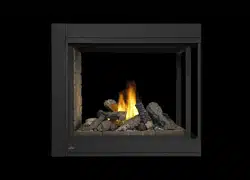Loading ...
Loading ...
Loading ...

EN
W415-1285 / L / 10.25.21
21
framing
4.0 framing
Maintain these minimum clearances to combustibles from appliance and vent surfaces:
Combustible Appliance framing:
- 1/4" (6.4mm) to the sides of appliance
- 8 1/4" (210mm) to the top of appliance
Combustible Appliance finishing:
- 0" (0mm) above the appliance opening
- 50" (127cm) from bottom of appliance to enclosure top
- 62 1/4" (158.2cm) from bottom of appliance to ceiling
- 3" (76mm) to top of vent pipe*
- 2" (51mm) to sides and bottom of vent pipe*
- 0" (0mm) to the sides and top of appliance
It is best to frame your appliance after it is positioned and the vent system is installed.
When roughing in the appliance, raise the appliance to accommodate for the thickness of the finished floor materi-
als, i.e. tile, carpeting and hard wood.
*HORIZONTAL VENT SECTIONS: A minimum clearance of 3" (76mm) to the top and 2" (51mm) to the sides and
bottom of the vent pipe on all horizontal runs to combustibles is required, see "minimum clearance to combustible
enclosures" section.
*VERTICAL VENT SECTIONS: A minimum of 2" (51mm) all around the vent pipe on all vertical runs to
combustibles is required.
!
WARNING
• Risk of fi re!
• In order to avoid the possibility of exposed insulation or vapour barrier coming in contact with the appliance
body, it is recommended that the walls of the appliance enclosure be “fi nished” (i.e. drywall / sheetrock),
as you would fi nish any other outside wall of a home. This will ensure that clearance to combustibles is
maintained within the cavity.
• Do not notch the framing around the appliance stand offs. Failure to maintain air space clearance may cause
over heating and fi re. Prevent contact with sagging or loose insulation or framing and other combustible
materials. Block opening into the chase to prevent entry of blown-in insulation. Make sure insulation and
other materials are secured.
• When constructing the enclosure, allow for fi nishing material thickness to maintain clearances. Framing or
fi nishing material closer than the minimums listed must be constructed entirely of non-combustible materials.
Materials consisting entirely of steel, iron, brick, tile, concrete, slate, glass or plasters, or any combination
thereof are suitable. Materials that are reported as passing ASTM E136, standard test method for behaviour
of materials in a vertical tube furnace at 1382ºF (750ºC) and UL763 shall be considered non-combustible
materials.
• Minimum clearance to combusibles must be maintained or a serious fi re hazard could result.
• The appliance requires a minimum enclosure height. Measure from the appliance base.
• If steel stud framing kits with cement board are provided, or specifi ed in the installation instructions, they
must be installed.
• If specifi ed in the installation instruction, fi nishing must be done using a non-combustible board, ceramic tile,
marble, etc. Do NOT use wood or drywall. Any fi re rated drywall is not acceptable.
When using optional fi nishing accessories, the framing dimensions and fi nishing materials may differ from
what is outlined in the section below; refer to the leafl et instructions supplied in the accessory kit for specifi c
framing and fi nishing specifi cations.
44.1
note:
The minimum clearances around the horizontal vent pipe to combustible materials may be reduced from 3"
(76.2mm) / 2" (50.8mm) to 1" (25mm) in those installations with a minimum 52" (132cm) vertical vent rise made
immediately off the appliance collar and where the vent has been reduced to 4/7" from 5/8" at the appliance
collars.
note:
Loading ...
Loading ...
Loading ...
